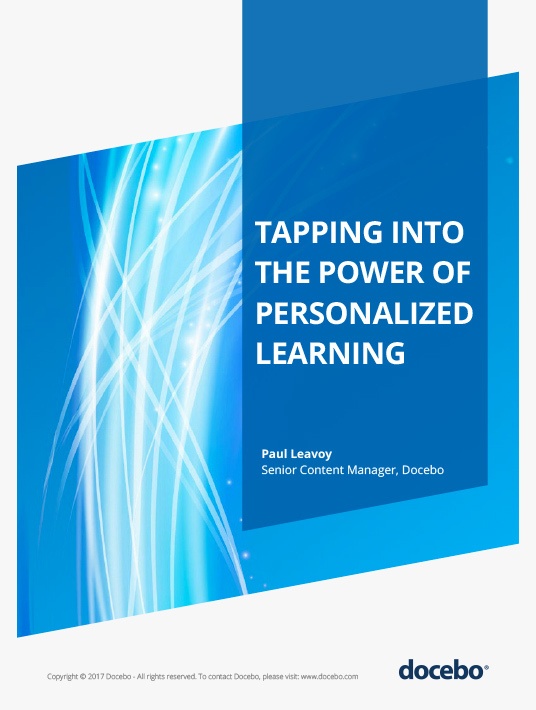What You Need To Know About Personalized Learning
Here’s the problem: In ancient Greece, mankind had the opportunity to assign one teacher to one learner. It’s an ideal arrangement, after all. No programs. No script. No Learning Management System. No software. Just a student and his teacher, in a low-population environment, figuring out their roles in work and life with one another. How delightful. Enter the 21st Century. Tech. Manufacturing. Demands. Immediacy. Computers. Internet. And the overwhelming pace of getting things done as soon as possible, and faster, at whatever cost. For whatever reason.

Suddenly, it isn’t acceptable -from a competitive business perspective- to teach and learn at the pace of the learner. Instead it is all about expediting the learner journey as much as possible.
Enter personalized learning.
So what is personalized learning? Well, it’s complicated, but it’s also not. The simple part is this:
Personalized learning makes the individual learner the centre of the learning path. It is tempting to think that we can put individual learners into certain categories of learning and develop plans for them to lean within those categories accordingly, but in actuality it does not work that well.
But it can be done.
Think of how you learn. And, beyond that, think of all the patterns and behaviors you express online, personally, and in your job function. What do you search? How do you absorb knowledge?
How do you exercise that knowledge in a job-related context?
These are all questions a personalized learning program would incorporate in your individualized learning program, in an ideal world. Of course, we’re not there yet, but we will be. For now, a proper personalized learning path draws on all the cues it can take from you, as a learner, in terms of how you grow and progress.
Personalized learning ultimately looks at our behavior, including how we have acted and interacted in the past and how we continue to do so in the present. Eventually, once technology and artificial intelligence (AI) catch up (which will be soon), personalized learning programs will also anticipate how learners desire to learn and what kind of content the need to learn from in the future, as they progress.
One way of defining it is this:
“The diverse variety of instructional programs, learning experiences, didactic approaches, and support strategies intended to address the unique and individual learning needs, interests, and aspirations of individual learners.”
Another way to think of personalized learning is to relate it to two online tools many of us use on a day-to-day basis. Netflix, the popular online video application, automatically studies your viewing history, likes, and preferences to suggest in customized lists what you might be interested in watching next. Similarly, Amazon.com assesses your search history along with your purchase history –not to mention the buying habits of individuals that have purchased items like those you have either bought or evaluated– to make suggestions of what you might buy next.
Both are rudimentary examples and don’t pertain to learning and development specifically, but they do illustrate how historical behavior and preferences can inform an algorithm that seeks to understand how you absorb content and what content you like to be exposed to. In essence, they’re tailored to the user, like personalized learning.
The Current State Of Personalized Learning
So, how many are actually using personalized learning in some form within their organization? We turned to Brandon Hall Group, a leading analyst firm on all things related to organizational performance excellence and learning and development, for the answers.
The Strategic Use Of Personalized Learning
To what extent do you use personalize learning in your learning strategy?
- All the time 10%
- Most of the time 36%
- Sometimes 48%
- Not at all 6%
Clearly, although a third of respondents to this survey believe personalized learning is integrated into their learning strategies, a bulk of respondents (nearly 60%) didn’t find personalized learning to be a focus.
Interestingly, when asked to relate personalized learning to social learning or the 70:20:10 approach in particular (which we have covered in depth) –an approach that pushes organizations to pursue a blended learning approach where learning achieves 70% of success through experiential learning, 20% through social/informal learning, and 10% through traditional, classroom-based learning– it was determined that most organizations found that personalized learning methodology aligned with the 70:20:10 approach.
Personalized Learning And 70:20:10
To what extent does personalized learning align with the 70:20:10 framework?
- Do not align 19%
- Somewhat align 36%
- Align 48%
- Strongly align 6%
Finally, personalized learning doesn’t happen in a vacuum. As determined by Brandon Hall Group in a related survey, organizations need a blend of coaching and mentoring, mobile learning, and social learning in order to facilitate proper personalized learning.
Realizing Effective Personalized Learning
The top 5 items for delivering effective personalized learning:
- Coaching and mentoring 78%
- Mobile learning 72%
- Social learning 69%
- eLearning modules on LMS or other learning tech 66%
- Video learning 61%
The Problem With Personalized Learning
We have one critical problem with the promise of personalized learning right now: Many believe it will be delivered by technology alone. Nothing could be further from the truth. As with so many organizational performance pursuits, we need a blend of the right people, the right processes, and the right technology to make an actual difference and implement personalized learning effectively.
It can be thought of as a three-legged stool: Without one of the legs in place, the whole thing will fall to the side. And that’s why it is important to incorporate people, process, and technology into any personalized learning approach, as we will illustrate below.
Learning Technology Must Be Supported By The Right People And Processes

If you want to delve more deeply into the topic of personalized learning, download the free eBook Tapping Into The Power Of Personalized Learning.









